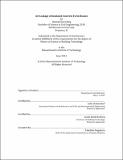Air leakage of Insulated Concrete Form houses
Author(s)
Durschlag, Hannah (Hanna Rebekah)
DownloadFull printable version (8.483Mb)
Alternative title
Air leakage of ICF houses
Other Contributors
Massachusetts Institute of Technology. Dept. of Architecture.
Terms of use
Metadata
Show full item recordAbstract
Air leakage has been shown to increase building energy use due to additional heating and cooling loads. Although many construction types have been examined for leakage, an exploration of a large number of Insulated Concrete Form (ICF) houses has not yet been completed. This thesis first collects 43 blower door tests of recently built ICF houses in North America. These are then examined and compared with a large collection of blower door tests of wood-stud construction. There is a 1.2% difference between ICF and wood-stud air leakage, with a very similar range. This range is mainly attributed to leakage from the attic space and cracks around windows based on a thorough investigation of two specific ICF houses in Nashville, TN. Using an EnergyPlus building model, the difference in air leakage between a typical ICF and wood-stud house in Chicago and Phoenix is not found to cause a significant gap in energy use. However, the range in air leakage does affect the amount of energy a single-family house consumes.
Description
Thesis (S.M. in Building Technology)--Massachusetts Institute of Technology, Dept. of Architecture, 2012. This electronic version was submitted by the student author. The certified thesis is available in the Institute Archives and Special Collections. Cataloged from student-submitted PDF version of thesis. Includes bibliographical references (p. 59-63).
Date issued
2012Department
Massachusetts Institute of Technology. Department of ArchitecturePublisher
Massachusetts Institute of Technology
Keywords
Architecture.